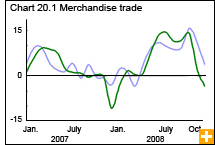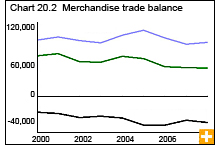Common menu bar links
International merchandise trade
Archived Content
Information identified as archived is provided for reference, research or recordkeeping purposes. It is not subject to the Government of Canada Web Standards and has not been altered or updated since it was archived. Please contact us to request a format other than those available.
Canada’s international merchandise trade showed strong expansion in early 2008 before the global economic downturn took hold later in the year. In the fourth quarter of 2008, the goods surplus dropped to its lowest level since the first quarter of 1994.
In the first half of 2008, the loonie was hovering around par with the U.S. dollar, making Canada’s exports more expensive in relation to imports. Meanwhile, commodity prices were rising—notably, oil prices neared $150 a barrel in July. The value of exported goods climbed in the first three quarters, supported by strong price gains (driven by energy) despite declining volumes.
Economic tide shifted rapidly
In August, the tide began to shift rapidly. The loonie retreated 15.8% to US$0.81 by year-end. As well, the seven-year boom in commodity prices ended, led by a drop in crude oil prices of over $100 a barrel. Commodity prices fell by more than half in just five months.
Autos and lumber were the industries that saw the largest declines. Exports of auto products dropped 9.2% in the fourth quarter of 2008 alone. The value of natural resource exports tumbled after July. Two-thirds of the decline was the result of lower prices.
Imports fell 6.4% in the fourth quarter.
Imports of auto products dropped 10.8%, while those of other consumer goods declined 9.0%. Lower imports of machinery and equipment, as well as industrial goods and materials, reflected lower business investment and stalling manufacturing activity.
Still, Canada exported a record $489.9 billion worth of merchandise in 2008, up 5.8% from 2007. The gain in exports in 2008 stemmed from surging prices in the first three quarters; volumes fell 7.8%. Prices fell in the fourth quarter, as the economic downturn began taking hold.
Energy products bolstered the overall gain in exports. Much of the increase occurred in the first six months of the year, when energy’s export prices increased 51.1%.
Also rising in 2008 were exports of industrial goods and materials, as well as those of agricultural and fishing products. These outweighed export declines for automotive products, forestry products and other consumer goods.
Canada’s imports topped $443.0 billion in 2008, a 6.7% increase from 2007. Energy products led the gain in imports on higher prices and volumes. As well, imports of agricultural and fishing products, industrial goods and materials, machinery and equipment, and other consumer goods increased in 2008, whereas imports of automotive and forestry products dropped.
Canada’s annual merchandise trade balance with the world decreased to $46.9 billion in 2008, continuing the contraction that began in 2005. Still, Canada’s trade surplus with the United States expanded to $89.1 billion in 2008 on the strength of crude oil exports.




